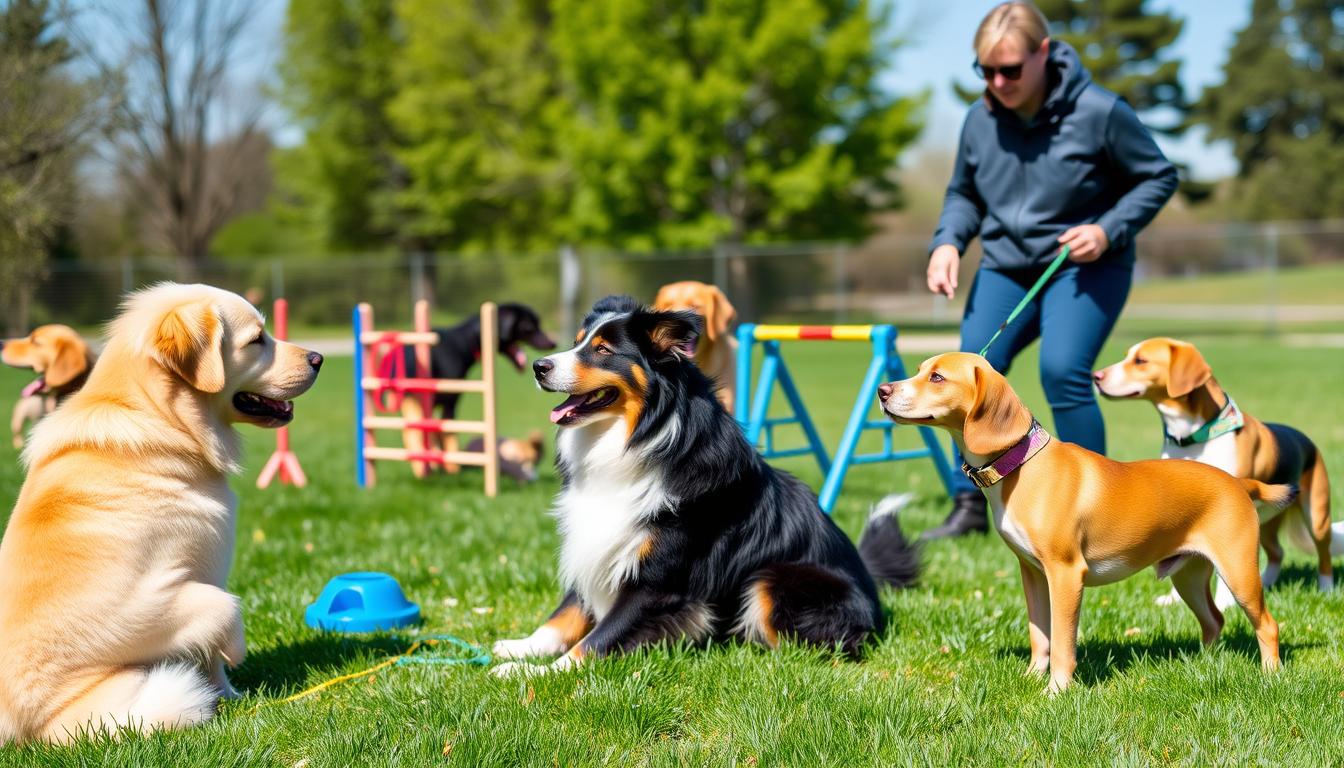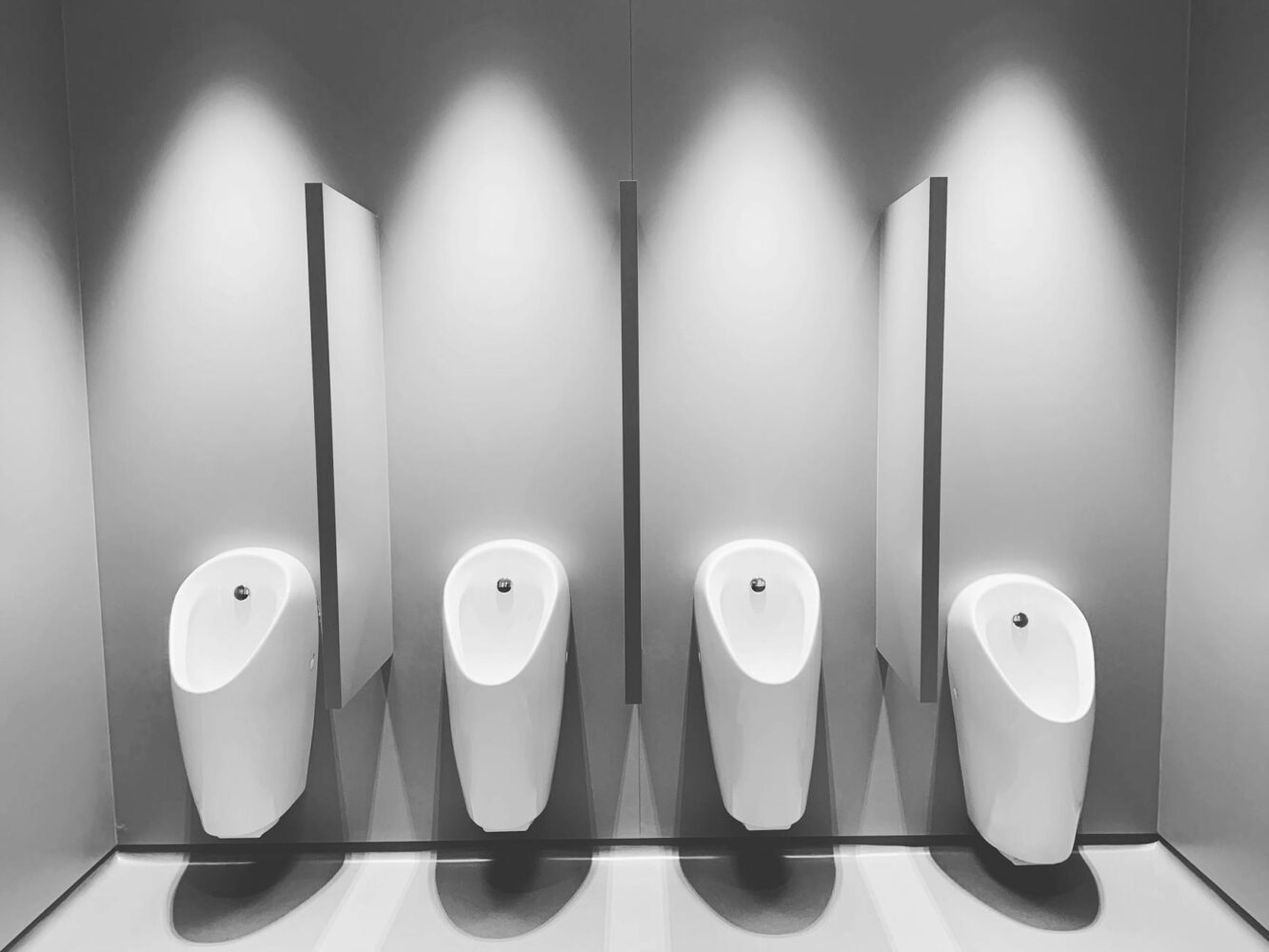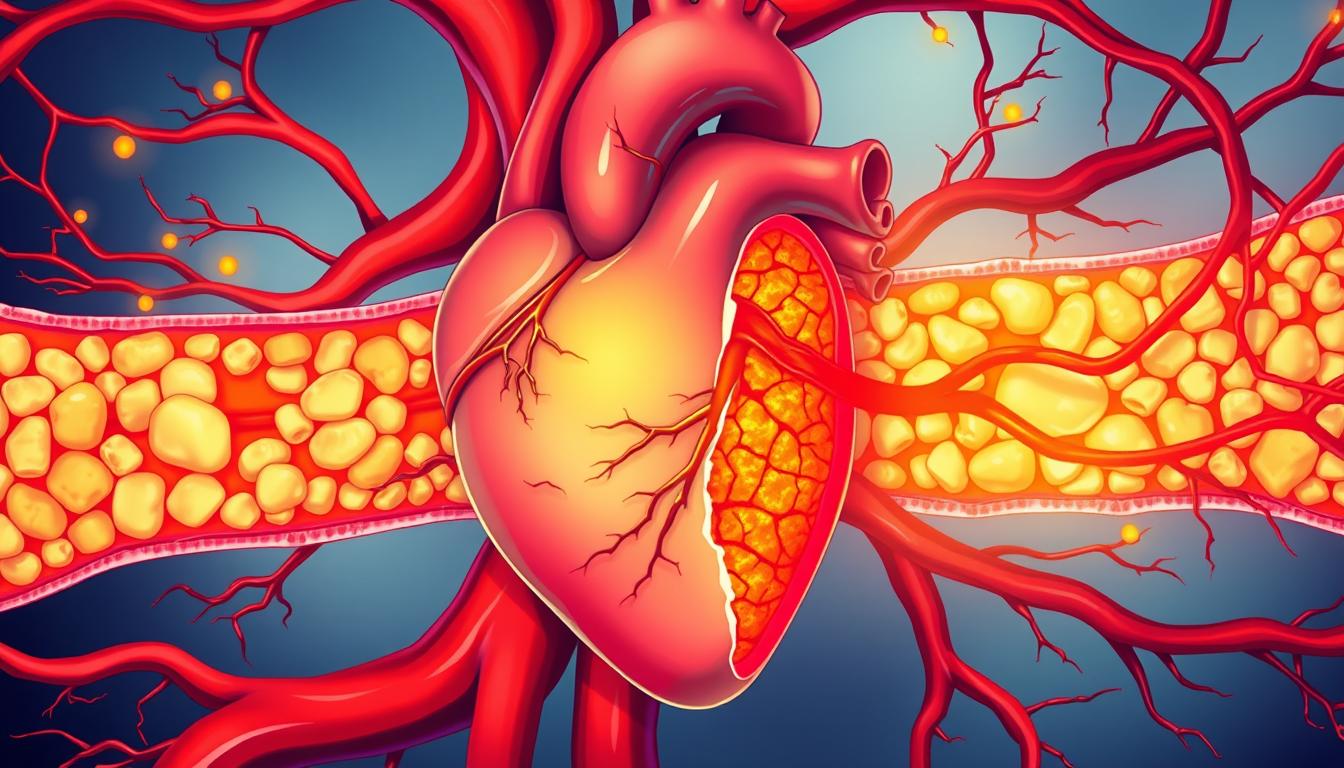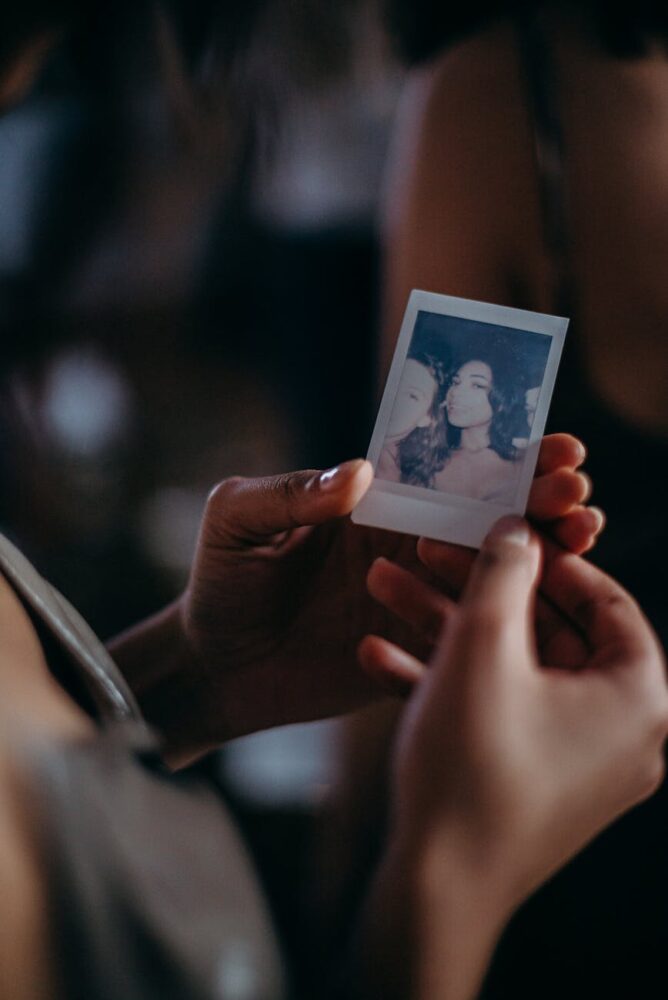Being a dog owner is full of joy and challenges. This guide will help you train your dog well. It’s perfect for new owners or those who need to refresh their training skills.
Get ready to strengthen your bond with your dog. You’ll learn how to bring out the best in them.
Key Takeaways
- Discover the power of positive reinforcement and how it can shape your dog’s behavior.
- Learn the art of clicker training and how it can help you communicate effectively with your canine companion.
- Master the basic obedience commands that form the foundation of a well-trained dog.
- Understand the importance of socialization and how it can help your puppy thrive.
- Explore behavior modification techniques to address any unwanted behaviors with patience and consistency.
Understanding the Fundamentals of Dog Training
Training your dog is a fun journey. It needs patience, consistency, and knowing the basics. Positive reinforcement is key. It rewards good behavior, making your dog want to do it again.
Positive Reinforcement and Its Importance
Positive reinforcement is the best way to train your dog. Give treats or praise when they behave well. This makes them want to keep doing it.
It’s better than punishing them. Punishment can hurt your bond with your dog.
Reward-based training is fun for dogs. They learn that good behavior gets them treats. This makes them happy to please you.
Establishing a Strong Bond with Your Canine Companion
Having a strong bond with your dog is important. Know their body language and how they communicate. This helps you understand them better.
Spending time together and being patient helps. A strong bond makes training easier. It also makes your time together better.
“The key to successful dog training is to focus on building a strong, positive relationship with your canine companion.”
Mastering the Art of Clicker Training
Clicker training is a great way to connect with your dog. It uses a small device to mark good behavior. This makes it a strong tool for teaching your dog.
At the core of clicker training is clicker conditioning. It pairs a “click” sound with a treat or praise. This teaches your dog to love the sound of the click.
- Clicker training is a highly effective, reward-based training technique.
- The clicker serves as a precise marker, helping your dog understand which behaviors you want to reward.
- Consistent pairing of the click sound with a positive reward conditions your dog to respond positively to the clicker.
Clicker training helps you see small changes in your dog’s behavior. It rewards these small steps. This helps shape your dog’s actions, good and bad.
“Clicker training is a powerful tool for building a strong bond between you and your dog, as it fosters trust, communication, and a shared language of learning.”
Learning clicker training takes time, but it’s worth it. It helps your dog learn and grow. It makes your bond stronger and more loving.
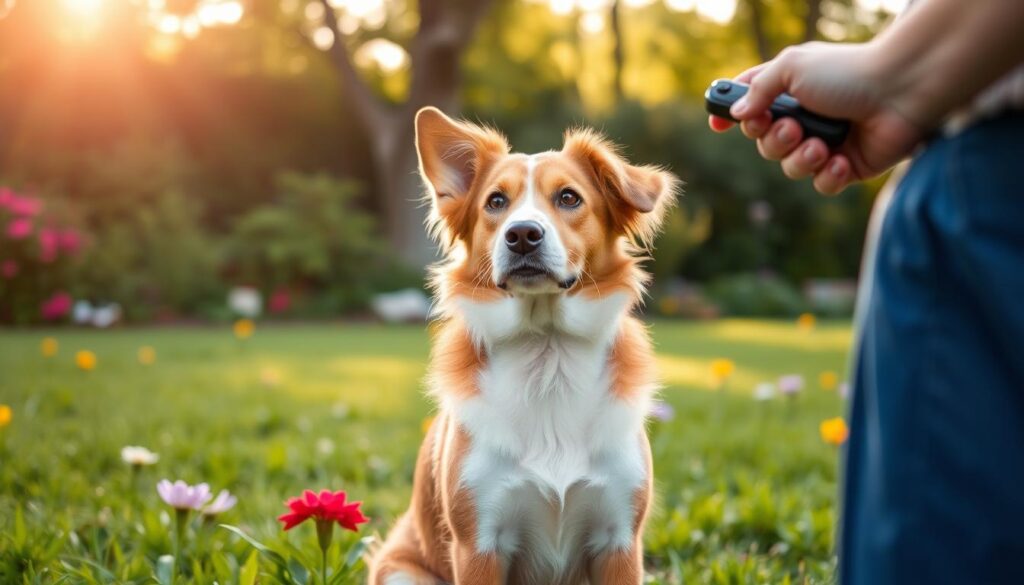
Dog Training: Professional Tips to Train Your Furry Friend
Teaching your dog basic obedience commands is key. You’ll learn to teach them sit, stay, come, and heel. Use positive methods and good training techniques.
Building a Foundation with Basic Obedience Commands
The basic obedience commands are the start of a well-behaved dog. Learning these commands helps you talk to your dog and keeps them safe.
- Sit: Teaching your dog to sit is a basic command. It shows you’re in charge and helps calm them down.
- Stay: The stay command keeps your dog in one place until you say it’s okay. It’s important for their safety, especially in public.
- Come: The come command is vital for getting your dog’s attention. It keeps them safe and under control. Training and positive feedback are essential.
- Heel: Teaching your dog to heel means they walk by your side. It’s important for walks and crowded places.
Training your dog needs patience and consistency. With regular practice and positive feedback, your dog will learn these commands. They’ll become a well-behaved and responsive friend.
Puppy Socialization: A Crucial Step
Socializing your young pup is very important. It shapes their behavior and how they feel for years. By showing them new environments, people, and things, you help them become a happy, confident dog.
Introducing Your Pup to New Environments and Experiences
The time to socialize your puppy is short, from 3 to 12 weeks. It’s key to show them many positive new environments and things. This helps them feel comfortable and ready for anything.
- Take your puppy on regular socialization outings, such as visits to pet-friendly stores, parks, and neighborhoods.
- Introduce your pup to people of all ages, sizes, and backgrounds, ensuring the interactions are gentle and positive.
- Expose your puppy to various sights, sounds, and textures, such as different flooring, stairs, and household items.
- Enroll your pup in a puppy training class to help them learn essential skills and socialize with other dogs in a controlled environment.
Remember, the key to successful puppy socialization is to make these experiences positive and rewarding for your furry friend. With patience and consistency, you can help your pup develop the confidence and adaptability they need to thrive in the world.
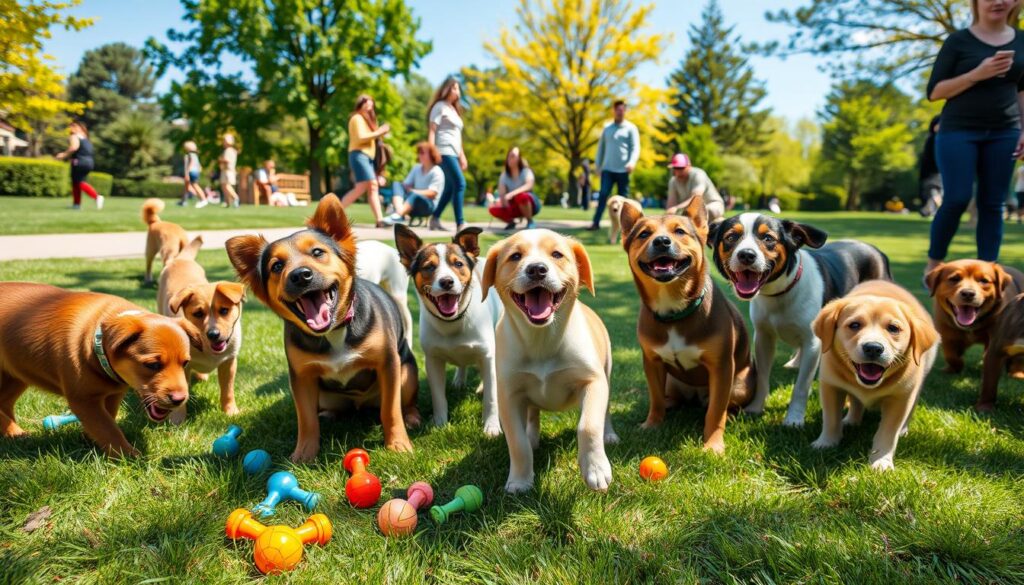
“Socialization is the foundation for a well-adjusted, confident dog. It’s a crucial step that should never be overlooked.”
Behavior Modification Techniques
As pet owners, we sometimes face challenges with our dogs’ behaviors. But, with the right approach and patience, you can change your dog’s behavior. This way, they can become the well-behaved friends we all want.
Addressing Unwanted Behaviors with Patience and Consistency
The key to changing behavior is positive reinforcement. Rewarding your dog for good behavior encourages them. This method is better than punishing bad behavior because it builds trust.
- First, figure out why your dog is acting out. Are they seeking attention or bored?
- Always reward your dog with treats or praise when they behave well. This makes them remember the good behavior.
- Stay patient and keep trying. Changing behavior takes time. Don’t scold or punish your dog, as it can hurt your bond.
Every dog is different, so what works for one might not work for another. It’s key to understand your dog’s needs and adjust your training. With patience, consistency, and positive reinforcement, you can help your dog overcome bad behaviors. This way, they can become the well-behaved friend you both want.
Crate Training: A Safe Haven for Your Furry Friend
Crate training is great for dogs. It gives them a safe and comfy place. It helps with housetraining and makes them feel secure.
To make crate training work, make the crate a positive association for your dog. Put the crate in a busy area of your home. Leave the door open so your dog can explore it.
Put treats or toys inside to encourage them to go in. Never use the crate as punishment.
- Start with short crate times and slowly increase it.
- Make the crate cozy with comfy bedding and toys.
- Use the crate when you can’t watch your dog, like during meals or naps.
By following these crate training tips, you’ll make your dog love their crate. This helps with housetraining and gives them a safe place when they need it.
“A well-trained dog is a happy, confident dog, and crate training is an essential tool in achieving that goal.”
Conclusion
We’ve looked at many tips and techniques for training your dog. You now know how to use positive reinforcement and clicker training. You also know the basics of obedience commands.
Training your dog is a long-term effort. Be patient and always think about your dog’s happiness. By using the tips from this article, you’ll grow closer to your dog. You’ll have a happy and loyal pet for life.
Whether you’re new to dog ownership or have experience, this guide helps you. It shows you how to face challenges and help your dog reach its full potential. Enjoy the journey and celebrate every small success with your happy and well-trained dog.
